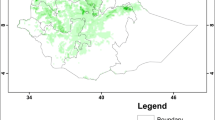Abstract
Three years of field data in northeastern Nebraska demonstrate that a grain sorghum crop reduces weediness in the following crop year. Weed growth was consistently lower in sorghum areas the year after strip-cropping fields with sequences of four-row bands of grain sorghum, soybeans, and corn. Percentage weed cover was significantly lower early in the year, and midsummer weed biomass was well below that found after corn and soybeans. Weed biomass in June and July following corn was two to four times that of grain sorghum strips. Inhibitory effects of grain sorghum were primarily on broadleaf weeds, often showing no action on grass weeds. No obvious differences were noted in the weed species present after the three crops. Allelopathy provides a logical explanation for the sorghum-mediated weed inhibition found in this study. The data have implications for weed management strategies in agriculture.
Similar content being viewed by others
References
Abdul-Wahab, A.S., andRice, E.L. 1967. Plant inhibition by Johnson grass and its possible significance in old-field succession.Bull. Torrey Bot. Club 94:486–497.
Alsaadawi, I.S., Al-Uqaili, J.K., Alrubeaa, A.J., andAl-Hadithy, S.M. 1986. Allelopathic suppression of weed and nitrification by selected cultivars ofSorghum bicolor (L.) Moench.J. Chem. Ecol. 12:209–219.
Crockett, J.J. 1964. Influence of soils and parent materials on grasslands of the Wichita Mountains Wildlife Refuge, Oklahoma.Ecology 45:326–335.
Einhellig, F.A. 1987. Interactions among allelochemicals and other stress factors of the plant environment, pp. 343–357,in G.R. Waller (ed.). Symposium on Allelochemicals: Role in Agriculture and Forestry. ACS Symposium Series No. 330. American Chemical Society, Washington, D.C.
Einhellig, F.A., andLeather, G.R. 1988. Potentials for exploiting allelopathy to enhance crop production.J. Chem. Ecol. 14:1829–1844.
Einhellig, F.A., Schon, M.K., andRasmussen, J.A. 1982. Synergistic inhibitory effects of four cinnamic acid compounds on grain sorghum.J. Plant Growth Regul. 1:251–258.
Forney, D.R., Foy, C.L., andWolf, D.D. 1985. Weed suppression in no-till alfalfa (Medicago sativa) by prior cropping of summer-annual forage grasses.Weed Sci. 33:490–497.
Guenzi, W.D., andMcCalla, T.M. 1966a. Phenolic acids in oats, wheat, sorghum, and corn residues and their phytotoxicity.Agron. J. 58:303–304.
Guenzi, W.D., andMccalla, T.M. 1966b. Phytotoxic substances extracted from soil.Soil Sci. Soc. Am. Proc. 30:214–216.
Guenzi, W.D., Mccalla, T.M., andNordstadt, F.A. 1967. Presence and persistence of phytotoxic substances in wheat, oat, corn, and sorghum residues.Agron. J. 59:163–165.
Hussain, P., andGadoon, M.A. 1981. Allelopathic effects ofSorghum vulgare Pers.Oecologia 51:284–288.
Lehle, F.R., andPutnam, A.R. 1982. Quantification of allelopathic potential of sorghum residues by novel indexing of Richards' function fitted to cumulative cress seed germination curves.Plant Physiol. 69:1212–1216.
Lehle, F.R., andPutnam, A.R. 1983. Allelopathic potential of sorghum (Sorghum bicolor): Isolation of seed germination inhibitors.J. Chem. Ecol. 9:1223–1234.
Martin, J.H., Couch, J.F., andBriese, R.R. 1938. Hydrocyanic acid content of different parts of the sorghum plant.J. Am. Soc. Agron. 30:725–734.
Milliron, L.E. 1985. Soil Survey of Cedar County, Nebraska. United States Department of Agriculture, Soil Conservation Service. 206 pp.
Nicollier, G.F., Pope, D.F., andThompson, A.C. 1983. Biological activity of dhurrin and other compounds from Johnson grass (Sorghum halepense).J. Agric. Food Chem. 31:744–748.
Overland, L. 1966. The role of allelopathic substances in “smother crop” barley.Am. J. Bot. 53:423–432.
Panasiuk, O., Bills, D.D., andLeather, G.R. 1986. Allelopathic influence ofSorghum bicolor on weeds during germination and early development of seedlings.J. Chem. Ecol. 12:1533–1543.
Putnam, A.R., andDefrank, J. 1983. Use of phytotoxic plant residues for selective weed control.Crop Prot. 2:173–181.
Putnam, A.R., Defrank, J., andBarnes, J.P. 1983. Exploitation of allelopathy for weed control in annual and perennial cropping systems.J. Chem. Ecol. 8:1001–1010.
Roberts, E.H., andSmith, R.D. 1977. Dormancy and the pentose phosphate pathway, pp. 385–411,in A.A. Khan (ed.). The Physiology and Biochemistry of Seed Dormancy in Germination. North Holland Publishing Company, Amsterdam.
Vincent, E.M., andRoberts, E.H. 1977. The interaction of light, nitrate and alternating temperatures in promoting the germination of dormant seeds of common weed species.Seed Sci. Technol. 5:659–670.
Woodhead, S. 1981. Environmental and biotic factors affecting the phenolic content of different cultivars ofSorghum bicolor.J. Chem. Ecol. 7:1035–1047.
Author information
Authors and Affiliations
Rights and permissions
About this article
Cite this article
Einhellig, F.A., Rasmussen, J.A. Prior cropping with grain sorghum inhibits weeds. J Chem Ecol 15, 951–960 (1989). https://doi.org/10.1007/BF01015190
Received:
Accepted:
Issue Date:
DOI: https://doi.org/10.1007/BF01015190




